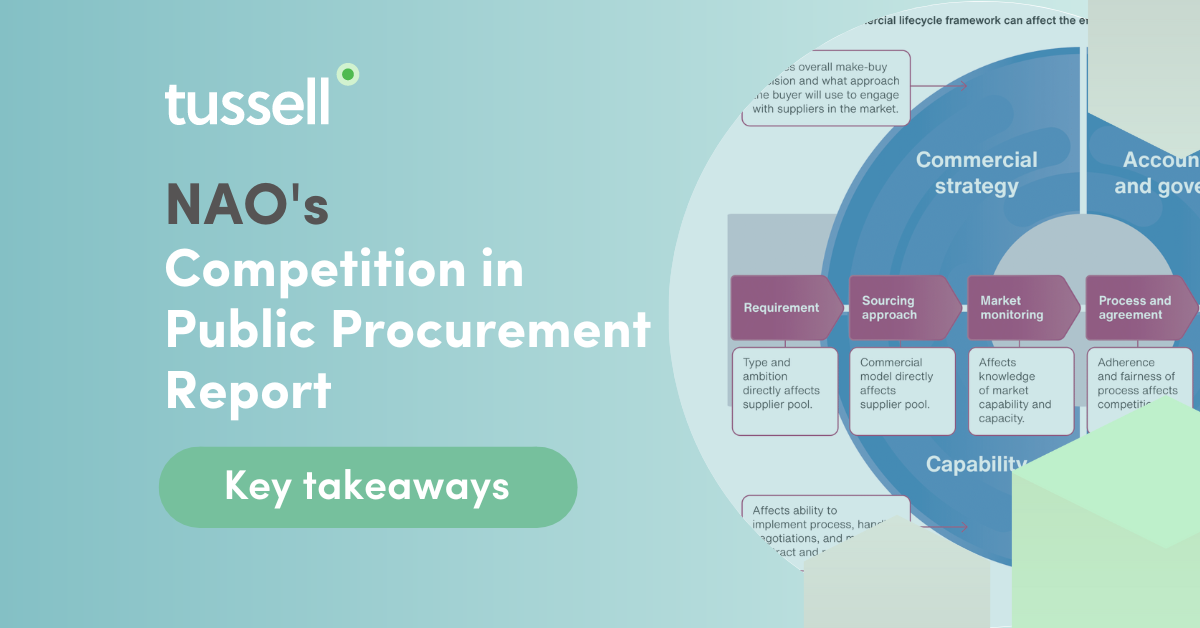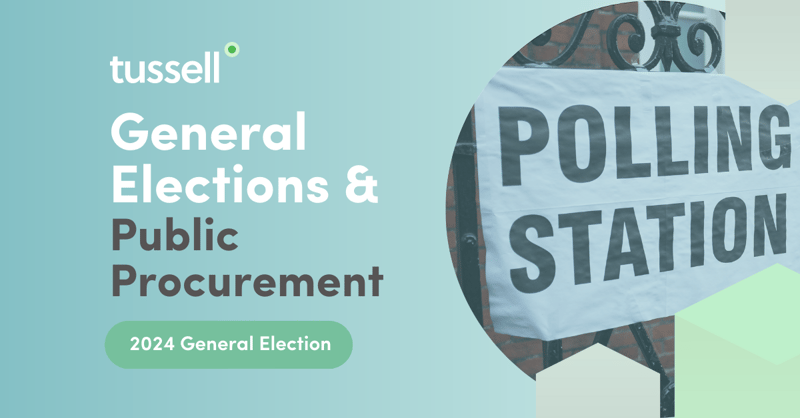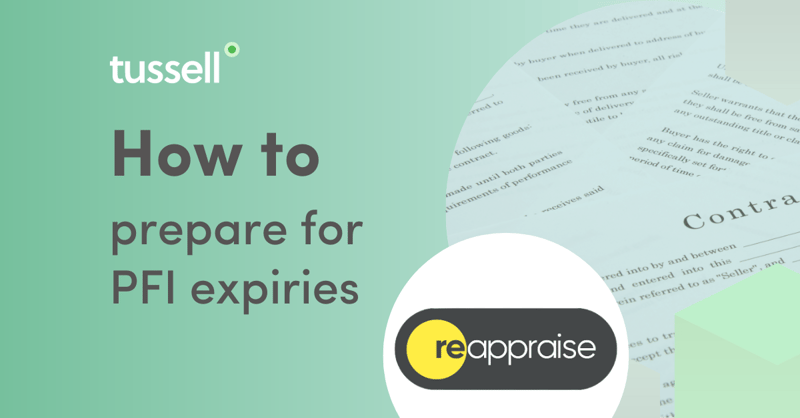In July 2023, the National Audit Office (NAO) published a report examining whether Central Government departments - and its arms-length bodies - have sufficient mechanisms to enable effective competition in its procurement processes, and how these could be improved.
The report's findings and recommendations are important not just for Central Government, but for all contracting authorities who want to bolster competition and value-for-money in their procurement.
In this blog, we've condensed down the NAO's report into a handy summary.
📣 The headline findings
Overall, the NAO argues that while the government understands the importance and benefits of competition in procurement, its impact is not fully appreciated, nor is it being implemented to its fullest extent.
The NAO found that "the government cannot show how well competition is working, and that the structures to encourage and support the use of competition are not all working as intended".
Best practice is not always followed (namely, extending rather than re-tendering contracts), and the Cabinet Office is not making best use of its own data on contract awards and tenders to understand more about the competitive landscape.
With these findings, the NAO lays out a number of lessons and recommended changes for public bodies to make (see below)
*
Drilling into this in a bit more detail, the report's core findings include that:
🏛️ The government has structures in place to promote competition in public procurement
The first portion of the NAO's report details the existing mechanisms in place to promote competition in central government procurement.
At the heart of the government's current legislative framework for procurement - Procurement Contract Regulations 2015 - is the conviction that competitive procurement produces more cost-effective, personalised and transparent solutions to the public sector's problems.
Organisations like the Government Commercial Function (GCF) and Competitions & Markets Authority (CMA) have helped to establish open competition as the "default approach for government procurement", while Cabinet Office-issued guidance documents (like the Consultancy Playbook) lay out what best practice competitive procurement looks like.
Other mechanisms - like the requirement for departments to submit business cases for high-value contracts for the Cabinet Office for review - also go some way to embed competitive practice.
📜 The government is not publishing procurement data promptly nor fully
The NAO argues that the timely publication of "public service delivery data" - like tender notices, contract award notices, procurement pipelines etc. - is vital for the proper functioning "of competitive, innovative, and open markets".
However, the NAO found that only 1 out of 16 analysed Central Government departments met the standard of publishing 85% of their contract award notices within 30 days (across 3 analysed quarters in 2022).
The NAO also found considerable inconsistencies in the quantity and quality of information published to places like Find a Tender and Contracts Finder.
Delayed or poorly inputted procurement data negatively affects competition, argues the NAO, and the Cabinet Office could be doing much more to enforce and expand the procurement datasets published by Central Government.
📈 Frameworks are being overused at the expense of open competitive procedures
After analysing which procedure routes government departments were using to procure work, the NAO found that the usage of frameworks has drastically expanded over the last few years.
Between 2018/19 and 2021/22, the proportion of analysed central government contracts awarded via a framework grew from 43% to 72%.
Indeed, Tussell's framework analytics shows that 2022 saw the highest-ever volume of Central Governments contracts being awarded via a framework (at least 31,300).
The NAO also found that the number of contracts awarded through open procedure decreased from 25% to 14% between 2018/19 and 2021/22.
The NAO argues that while frameworks alleviate some of the administrative burdens associated with open procurement procedures, they "are not always the way to achieve the best competition." Frameworks can, for example, limit competition by reserving competition to just a small handful of suppliers, or by being open to too large a pool of suppliers to enable proper competitive comparison.
Again, the NAO's own analysis of procurement procedure types was hampered by the government's poor publication quality and regularity.
💡 Open data is not being harnessed to bolster competition
The poor quality of open procurement data combined with a lack of embedded procedures means that the procurement data which is available isn't being fully utilised by government to understand the competitive landscape.
"There remains clear potential to gain insight and learn lessons through further analysis of data on contracts and competitions". Though the Cabinet Office currently analyses the state of some key markets, it does "not currently make the most of the potential of the data it collects".
To learn how Tussell is aggregating open procurement data into smart, actionable data that you can utilise, click here.
✔️ Maximising competition in your procurement
Using its commercial lifecycle framework as a basis, the NAO recommends a number of lessons that public bodies should heed to improve competition throughout their procurement.
Case-studies are referred to throughout to help illustrate these lessons.
Broken down by procurement "procedural stage", these include:
Requirement stage
("the start of the competitive/commercial process, where underlying policy objectives help establish the outcomes to be achieved")
-
Overambitious requirements can stifle competition by limiting the potential supplier pool; a better understanding of your market and its maturity will help you understand what most suppliers can typically provide
-
Requirements should be clear for suppliers, but also provide a degree of flexibility to allow for uncertainties once the requirement is being delivered
-
Authorities need thorough costs and benefits analyses in order to set out requirements more accurately, and to provide suppliers with the right data to competitively price their bids
Sourcing stage
(deciding "whether the requirements can be fulfilled in-house, or if they will need to be sourced from the market. If using the market, then the buyer will have to determine the method and intensity of market engagement that will produce the best result")
-
When choosing a competitive approach, contracting authorities need to be mindful of supplier exits and failures when turning to the market
-
Be aware of how delivering large-scale projects through multi-contract arrangements have more failure points
-
If you opt to use a framework, ensure it contains the kind of suppliers who can actually cater to your requirement's niche
Market monitoring
(When contracting authorities should make "an assessment of the market early on during the preparation and planning stage", including "engaging with potential suppliers throughout the commercial lifecycle")
-
Sharing information and feedback with stakeholders & suppliers pre-tender creates a more competitive market; creating channels of communication increases trust
-
Gathering market intelligence - both from other buyers and suppliers - helps contracting authorities to make more informed procurement decisions, and become aware of more cost-effective alternatives (e.g. joint procurement opportunities)
-
Engage with potential suppliers early to anticipate their capabilities, before doing business with them
Contracting authorities across the UK are using Tussell to gather intelligence on potential suppliers, their categories, frameworks and on what other contracting authorities are purchasing. To learn more about these insights, click here.
Process & agreement phrase
(The "end-to-end process that starts with the department issuing documentation, handling supplier engagement, and evaluating any bids received before making and communicating the decision")
-
Contracting authorities should tailor their contractual approaches to the reflect the contract's ultimate purpose
-
Pricing should be used as an incentive to keep suppliers in play, while maintaining competitive pressure
-
Evaluating bids needs to be done in a fair and transparent manner to maintain supplier confidence; this includes providing detailed feedback to both winning and losing bids
Contract management phase
("This encompasses all the formal and informal activities relating to the performance and monitoring of a contract.")
-
'In-life' mechanisms - like regular benchmarking - should be employed to ensure suppliers are fulfilling their contractual obligations
-
Mechanisms to collect data on the contract's progression, to ensure it's meeting objectives
-
Considerations must be given to potential blockers, like sub-contractors, in enabling the success of a contract
Contract review, transition and exit phase
("The review, transition and exit stage encompasses the factors that inform a
decision on the extension or re-procurement of a requirement")
-
Ensure you keep up-to-date on your suppliers' financial health and general market conditions, to inform future procurement decisions
-
Maintain contingency plans for supplier failure
-
Acknowledge that while implementing shorter contracts can create more opportunities for competition, they are more likely to incur delays through having to continually onboard new suppliers
*
The NAO's report ultimately argues that while competition is at the heart of procurement in the public sector, not enough is being done to actively monitor or promote it.
To help promote competitive practices in your procurement, you'd do well to acknowledge and incorporate the NAO's key lessons for each stage of the procurement process.
More fundamentally, however, is the question of how you can harness hard data to better understand what's on offer, and make more informed, competitive procurement decisions. As the NAO argues, the state of open procurement data right now makes this task incredibly hard.
You need a tool like Tussell - which aggregates and cleanses all publicly available procurement data into one place - to access this kind of intelligence quickly. To learn how contracting authorities are already using Tussell to make smarter procurement decisions, click here.



%20v1.png)
![New Nav Bar - New Tag [Gov]](https://www.tussell.com/hubfs/New%20Nav%20Bar%20-%20New%20Tag%20%5BGov%5D.png)
![[Gov] New Nav CTA - Product, Frameworks Finder (rounded) v1](https://www.tussell.com/hubfs/%5BGov%5D%20New%20Nav%20CTA%20-%20Product%2c%20Frameworks%20Finder%20(rounded)%20v1.png)


.png?width=80&height=80&name=james%20v2%20(1).png)

![New Nav Bar, Insights - Strategic Suppliers 2025 [Gov] v2](https://www.tussell.com/hs-fs/hubfs/New%20Nav%20Bar%2c%20Insights%20-%20Strategic%20Suppliers%202025%20%5BGov%5D%20v2.png?width=600&height=600&name=New%20Nav%20Bar%2c%20Insights%20-%20Strategic%20Suppliers%202025%20%5BGov%5D%20v2.png)





